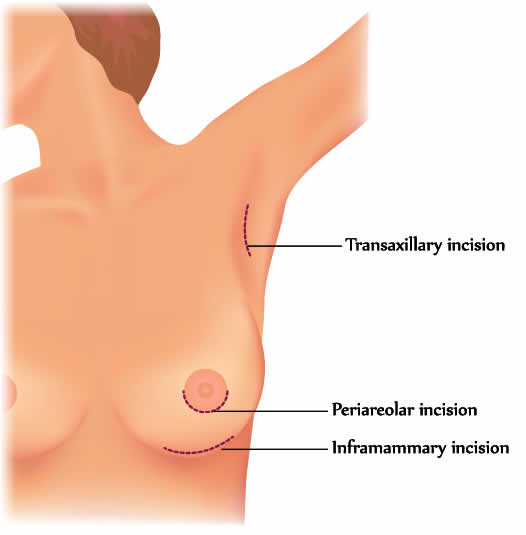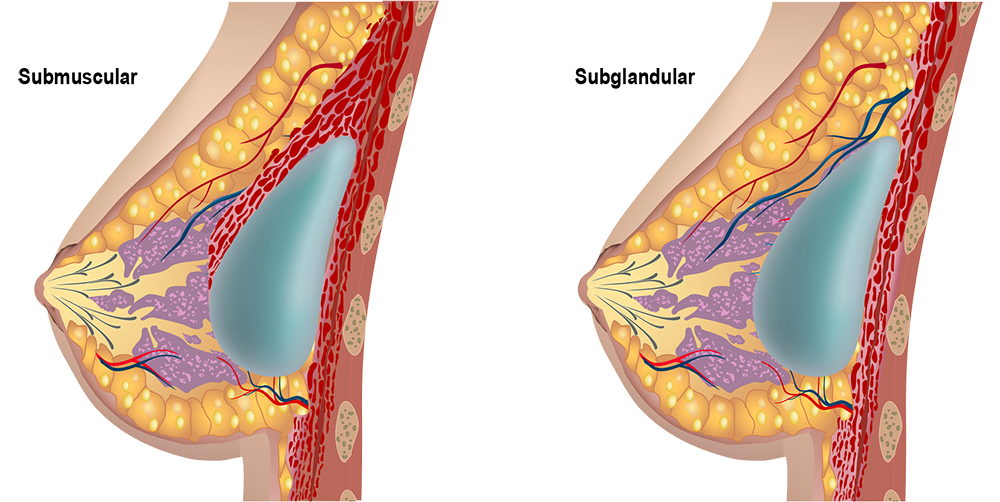

Breast enlargement, also called Augmentation Mammaplasty, is one of the most commonly performed procedures in plastic surgery because of its ability to quickly and dramatically improve a woman’s appearance. Breast augmentation can increase the fullness and projection of your breast, improve the balance of your figure, and enhance your self-image and self-confidence. Breast augmentation does this through the use of saline-filled or silicone-filled breast implants, which are usually placed behind your breast and chest wall muscle. Women choose to have breast augmentation performed for a variety of reasons. Pregnancy, breast-feeding, and weight fluctuation have a significant impact on the volume, firmness, and symmetry of the breast, causing a woman to feel self-conscious and dissatisfied with their appearance. Others feel that their breasts are under-developed and wish to have fuller, larger breasts, which are more proportional to their body.
During your consultation, your medical history, drug allergies and current medications will be reviewed and a detailed breast history will be obtained. For most patients, it is advisable to have a mammogram prior to surgery. Dr. Saar or Dr. O’Halloran will discuss why you want breast augmentation surgery, your expectations from surgery, and your desired outcomes. Anytime a woman considers undergoing breast augmentation surgery, it’s natural to feel some anxiety, so don’t be shy about discussing these feelings during your consultation. Dr. Saar or Dr. O’Halloran will examine your breasts, including detailed breast measurements, skin quality and nipple position. Based on these finding, your options for breast enhancement will be discussed. The procedure of breast augmentation will be reviewed in detail including the likely outcomes, and any risks or potential complications associated with your surgery. You will also have the opportunity to try on different sizes of breast implants within a bra in order to help you determine the implant size that you feel is best for you.
Breast augmentation is performed on an outpatient basis, usually in an ambulatory surgery center, using general anesthesia. With general anesthesia you are completely asleep and do not feel any pain. In a breast augmentation procedure, an incision is most commonly made in the crease below the breast. The incision may be slightly longer if silicone-filled breast implants are used because they are pre-filled, whereas saline-filled breast implants are filled after placement. Implants are inserted either above the chest wall muscle (sub-glandular or pre-pectoral), or more commonly, below the muscle (sub-muscular or sub-pectoral). Placement under the muscle creates a more natural appearance and has a lower incidence of scarring around the implant (capsular contracture). Drains are not necessary, sutures are absorbable, and dressing can be removed in 24 hours. Typically, patients are able to return to work with in a few days after breast augmentation surgery, breast soreness usually resides after 1-2 weeks, and you may resume exercise in 4-6 weeks. The results of your breast augmentation surgery are immediately visible. Over time, post-surgical swelling will resolve and incision lines will fade. Satisfaction with your new image should continue to grow as you recover.


Breast implants are produced by several implant manufactures (Mentor, Allergan and Sientra) and come in a variety of types (saline or gel), styles (round or shaped and smooth or textured), profiles (moderate, moderate-plus, high and ultra-high), and sizes (measured in cc's).
Saline breast implants are a silicone shell filled with sterile salt water (IV fluid). Should the implant shell leak, a saline implant will collapse and the saline will be absorbed and naturally expelled by the body. Saline breast implants provide a uniform shape, firmness and feel, and are FDA-approved for augmentation in women age 18 or older. Gel breast implants are a silicone shell filled with silicone gel. The gel is softer and feels more like natural breast tissue. If the implant leaks, the gel may remain within the implant shell, or may escape into the breast implant pocket. A leaking implant filled with silicone gel will not collapse. Therefore, an ultrasound or a breast MRI is usually necessary to assess the condition of breast implants. Silicone breast implants are FDA-approved for augmentation in women age 22 or older.
Round breast implants have a tendency to make breasts appear fuller than shaped (anatomic or form-stable) implants. Because round implants are the same shape all over, there is less concern about them rotating out of place. Smooth breast implants are the softest feeling. These implants can move with the breast implant pocket, which may give more natural movement. Smooth implants may have some palpable or visible rippling. Textured breast implants develop scar tissue to stick to the implant, making them less likely to move around inside of the breast and get repositioned. Texturing may possibly offer a slight advantage in diminishing the risk of forming a tight scar capsule (capsular contracture) around the implant.
Implants profiles refer to the amount of projection in relation to the implant width for a given implant size. The higher profile options can achieve more projection and less width than the lower profiles. Dr. Saar or Dr. O’Halloran will help determine which profile will provide you with your desired outcome. Implants are manufactured in a variety of sizes ranging from 100 cc to 800 cc.
Implant manufacturers occasionally introduce new styles and types of breast implants, so there may be additional options available.
Whether you choose saline-filled or silicone gel-filled implants, it is important for you to monitor your breast implants and follow-up with your plastic surgeon for appropriate checkups.
Breast augmentation does not elevate the nipple position or correct sagging breasts. If you want your breasts to be lifted and have a higher nipple position, a breast lift procedure (mastopexy) may be required. Breast lifting can often be done at the same time as your augmentation or in some instance it may require a separate operation. Dr. Saar or Dr. O’Halloran will assist you in making this decision.